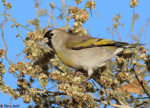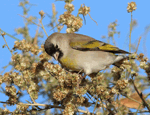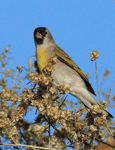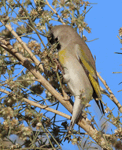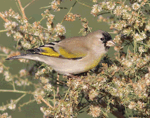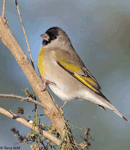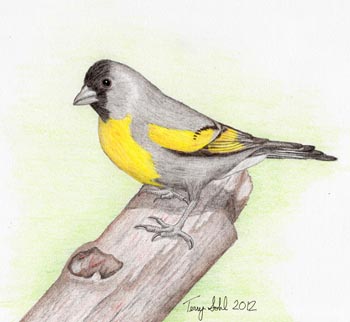Lawrence's Goldfinch
Spinus lawrencei
| Length: 4.75 inches | Wingspan: 8.25 inches | Seasonality: Non-resident in South Dakota |
| ID Keys: Grayish overall, males with black face and throat, yellow chest and parts of wings | ||
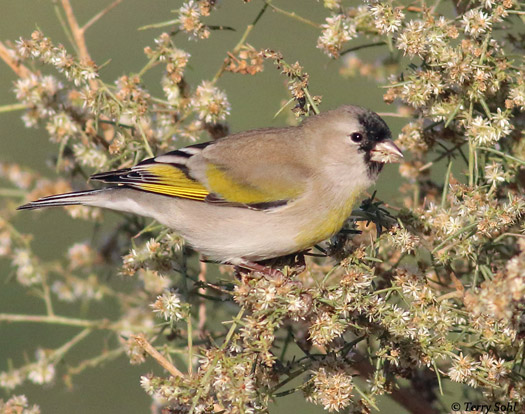 The
Lawrence's Goldfinch is a rather unusual, small finch species of
southwestern U.S. and Baja California. Never numerous, the total
species population is likely 150,000 or lower, and somewhat unknown
migration and movement patterns make it even more of a mysterious species.
Winter movements are variable, with significant numbers spreading into
Arizona and New Mexico occasionally, but absent in other years.
Presence on the summer breeding grounds can be equally as unpredictable, as
there are few reliable places where Lawrence's Goldfinch return to breed
each summer. Both winter and summer movements of the birds are likely
tied to the availability and abundance of its favored seed plants.
The
Lawrence's Goldfinch is a rather unusual, small finch species of
southwestern U.S. and Baja California. Never numerous, the total
species population is likely 150,000 or lower, and somewhat unknown
migration and movement patterns make it even more of a mysterious species.
Winter movements are variable, with significant numbers spreading into
Arizona and New Mexico occasionally, but absent in other years.
Presence on the summer breeding grounds can be equally as unpredictable, as
there are few reliable places where Lawrence's Goldfinch return to breed
each summer. Both winter and summer movements of the birds are likely
tied to the availability and abundance of its favored seed plants.
Habitat:
Can be found in a variety of habitats, including open woodlands, woodland and forest edges, and shrubby habitats such as chaparral. Generally found in dry habitats, but often very close to water sources in those habitats.
Diet:
Feeds heavily on the seeds of annual weeds and other plants. They will also take some insects on rare occasions, primarily during the summer breeding season.
Behavior:
Forages by landing on a weed or other plant, and plucking seeds from it.
Nesting:
Females build a nest of grasses and other plant material in the branches of trees, typically between 8 and 20 feet from the ground. The female incubates the eggs, with incubation lasting 12 to 14 days, but both male and female tend to the young and gather food.
Song:
Song of the males is a high tinkly series of warbling notes, typically sounding rather random and non-repeating. Click here to hear the song of a Lawrence's Goldfinch (audio courtesy of Lance Benner). They also have a simple, single note call given in flight. Click here to hear the flight call of a Lawrence's Goldfinch (audio courtesy of Richard Webster).
Migration:
Migration of the Lawrence's Goldfinch is poorly understood. The species primarily nests in California, but disappears in the winter. In some winters, significant numbers spread east and winter in Arizona and New Mexico. In other winters, the species is nowhere to be found in those states. The migration is rather unusual in that instead of latitudinal migration (north and south), their movements are primarily east/west.
Interactive eBird Map:
Click here to access an interactive eBird map of Lawrence's Goldfinch sightings
Feeders:
Will attend feeders for niger seed ("thistle").
Similar Species:
Lesser Goldfinch, American Goldfinch. While similar in structure to the other two North American goldfinch species, plumage patterns are unique enough to easily differentiate both male and female Lawrence's Goldfinch from American and Lesser Goldfinch. The yellow on the wings and yellow splash on the breast, present on both male and female birds, are not present in either American or Lesser Goldfinch. Click here to for a page that describes the differences among Lawrence's, American, and Lesser Goldfinch.
Conservation Status:
The IUCN currently lists the Lawrence's Goldfinch as a species of "Least Concern". However, total population numbers are probably less than 150,000, and the Audubon "WatchList" lists the bird as "highest concern". With such a small population size, and with a small range where urban development is rapidly occurring, habitat loss could have a big impact on the species.
Further Information:
1) WhatBird - Lawrence's Goldfinch
2) Audubon's Field Guide - Lawrence's Goldfinch
3) Arizona Field Ornithologists - Lawrence's Goldfinch
Image Information:
November 11th, 2015 - Tanque Verde Wash, Tucson, Arizona - Terry Sohl
| Click below for a higher-resolution map |
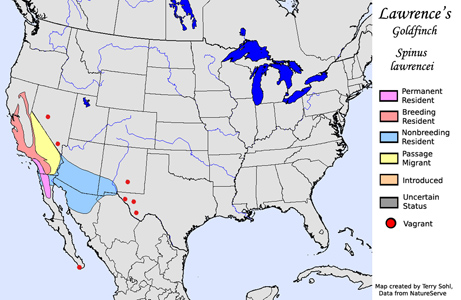 |
| South Dakota Status: Non-resident in South Dakota |
Additional Lawrence's Goldfinch Images
